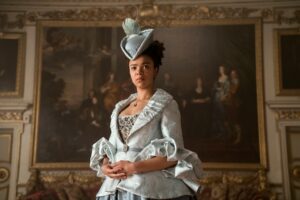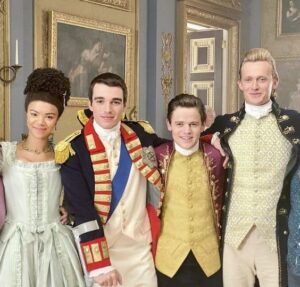Why ‘Queen Charlotte’ Says Yes to a Very Specific Wedding Dress
Costume designer Lyn Paolo and Laura Frecon told IndieWire about building Charlotte’s royal power from her first impression to final wedding gown.
One of the visual pleasures of Netflix‘s “Bridgerton” has been the series’ enthusiasm for bolder colors and costumes inspired — but never limited — by the styles of the Regency era. Clothing is how the show makes clear not just who has the social upper hand but each character’s approach to social climbing and self-confidence.
In the prequel series “Queen Charlotte: A Bridgerton Story,” costume designers Lyn Paolo and Laura Frecon (both Shondaland alumni) use the characters’ clothing to achieve those same ends from the moment we first meet the soon-to-be Queen (India Amarteifio) on her way to marry a man sight unseen. But for inspiration, they looked beyond the series’ era to something far more modern: the Met Ball.

“Laura and I are very conscious of being very respectful of the world that [Season 1 costume designer] Ellen Mirojnick created. It’s quite a wonderful world. But our story is an origin story,” Paolo said. “So we started with research, and then after reading Shonda’s version of ‘Queen Charlotte,’ we pitched that we wanted young Charlotte to feel more modern. Like you could wear these gowns to a Met Ball. It was more of a red carpet look than it was a period-correct look.”
That red carpet ethos is perhaps why Charlotte ultimately packs suck a punch when she dresses to make a statement: Her dresses are self-consciously designed to guide the conversation of the British upper class through fashion. But it was essential to the “Queen Charlotte” costume designers to create the right amount of contrast building up to that look, so we could visually catch the moment that Charlotte finds her voice in this new court she will, one day, preside over. That meant making both the dress she arrives in and the English wedding dress foisted upon her by the Queen Mother (Michelle Fairley) into Met Ball misses.
The dress in which Charlotte arrives at court is a surfeit of finery. “The carriage gown, which is actually a skirt and bodice with a Caraco jacket, was very well drawn-out in Shonda’s script,” Paolo said. “All of those descriptions — ‘I’m sitting here in this gown with this lace and these jewels’ — all of that was in the script. The only difference for us was we asked Shonda if we could change the dialogue to sapphires because we’d found this company while we were in London called Larkspur and Hawk who recreate Georgian jewelry and had asked them if they could create tiny little jewels that we could then stitch into the costume.”
Every single one of those tiny sapphires trembles as the carriage trundles along, betraying any sense of control that Charlotte would like to have over her life. It’s perfect for the moment when she confronts her brother Adolphus (Tunji Kasim) about the marriage and realizes that neither of them feels particularly in control over their futures. Indeed they aren’t, as Charlotte is almost immediately pressed into a wedding dress that states the (extremely limited) use Queen Augusta would like her to serve.“For the [English] wedding gown isn’t that plain really, but it feels consciously plain by comparison [to the carriage dress]. We interwove a lot of Yorkshire and Tudor roses into the hem of that gown, which were also woven into George’s costume for the wedding. Augusta didn’t include anything that was German in the British gown. It’s all England England England,” Paolo said.
The wedding gown may all but scream, “It’s Coming Home,” but it visually pairs Charlotte and George when they meet for the first time. George is the more boldly dressed, the more confident, at an even keel even as he catches Charlotte attempting to run away. The English gown represents a version of their relationship where Charlotte succumbs to George’s charm. But that isn’t who this young queen is, and so that isn’t the wedding dress she wears. Instead, she dons the very current (very French) gown she brought.
“Charlotte’s vision for that moment, as a young woman trying to figure out who she is and certainly to say, ‘This is who I am,’ was completely regal,” Paolo said. The sense of royalty comes, Frecon said, from the gown’s internal intricacy, as opposed to jewels stitched to the front of it. “It was embroidered by our machine embroiderer, Twan Lentjes, then it was hand-embroidered and embellished by our embellishers, and then we made the cape with a special sparkle. It was such a thing. And we did it because we really wanted Charlotte to be able to show, ‘This is me. This is who I am,’” Frecon said. “Then we had our jeweler, our in-house jeweler, and our milliner come together to make that tremblant crown, which was just spectacular.”

The resulting triumphant gown is a classic “Bridgerton” marriage of period-intricate stitch-work and modern shapes and colors, here taken from designer Charles James’ work. “There was a Met Ball done 10 years ago or so based on Charles James’ designs. So that really helped to inform us and, and guide us,” Frecon said.
But Charlotte’s statement of royal intent had to be designed with an awareness of her eventual style as the queen who lords over “Bridgerton” proper. “I relate [that gown] to the scene in ‘Elizabeth’ with Cate Blanchett, where she becomes the Virgin Queen,” Paolo said. “We have to follow [our version of the character] to answer the question of how did she end up being [the older] version of Queen Charlotte [Golda Rosheuvel].”
Even though “Queen Charlotte” sees Rosheuvel’s monarch in mourning blacks, her dresses have the same strong lines and intricacy of design as her younger self. “She’s a vision in black, with all that jet jewelry and the veiling and the embroidery on the veiling,” Paolo said. “The hand-beading, the hand-stitching, the embroidery and the jet jewelry that our team of artisans helped us create, they’re quite remarkable pieces of costume manufacturing.”
All these rich embellishments are designed to command the eyes of any room Charlotte walks into — even those full of her dissolute offspring. One only has to watch Rosheuvel in motion to see how successfully she pulls it off and how the light glints off the details of her gowns like armor. The tragedy of both the younger and the older Queen Charlotte is that the armor fits her just a little too well.
